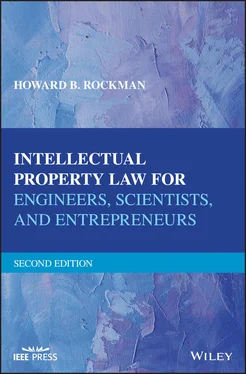Howard B. Rockman - Intellectual Property Law for Engineers, Scientists, and Entrepreneurs
Здесь есть возможность читать онлайн «Howard B. Rockman - Intellectual Property Law for Engineers, Scientists, and Entrepreneurs» — ознакомительный отрывок электронной книги совершенно бесплатно, а после прочтения отрывка купить полную версию. В некоторых случаях можно слушать аудио, скачать через торрент в формате fb2 и присутствует краткое содержание. Жанр: unrecognised, на английском языке. Описание произведения, (предисловие) а так же отзывы посетителей доступны на портале библиотеки ЛибКат.
- Название:Intellectual Property Law for Engineers, Scientists, and Entrepreneurs
- Автор:
- Жанр:
- Год:неизвестен
- ISBN:нет данных
- Рейтинг книги:5 / 5. Голосов: 1
-
Избранное:Добавить в избранное
- Отзывы:
-
Ваша оценка:
Intellectual Property Law for Engineers, Scientists, and Entrepreneurs: краткое содержание, описание и аннотация
Предлагаем к чтению аннотацию, описание, краткое содержание или предисловие (зависит от того, что написал сам автор книги «Intellectual Property Law for Engineers, Scientists, and Entrepreneurs»). Если вы не нашли необходимую информацию о книге — напишите в комментариях, мы постараемся отыскать её.
Now in its second edition,
enables inventors and creators to efficiently interface with an intellectual property attorney in order to obtain the maximum protection for their invention or creation, and to take steps to ensure that that invention or creation does not infringe upon the intellectual property rights of others. It includes patent, trade secret, mask work, and cybersquatting legal and procedural principles. The book also shows readers how to properly use new vehicles of intellectual property protection for novel software, biotech, and business method inventions. Additionally, it examines trademark protection for domain names, and other ancillary matters that fall within the genre of intellectual property protection. This informative text:
Covers all of the major areas of intellectual property development and protection in clear, layman’s terms so as to be easily understood by technology and science professionals Provides detailed outlines of patent, trademark, copyright, and unfair competition laws Offers essays on famous and noteworthy inventors and their inventions—and features a copy of the first page of patents resulting from these inventors’ efforts Covers many new high-profile cases covering patent protection within the mobile communications industry
is an excellent text for graduate and undergraduate engineering students, as well as professionals and those starting a new technology business who need to know all the laws concerning their inventions and creations.













